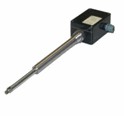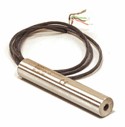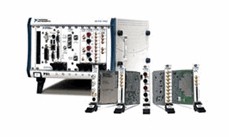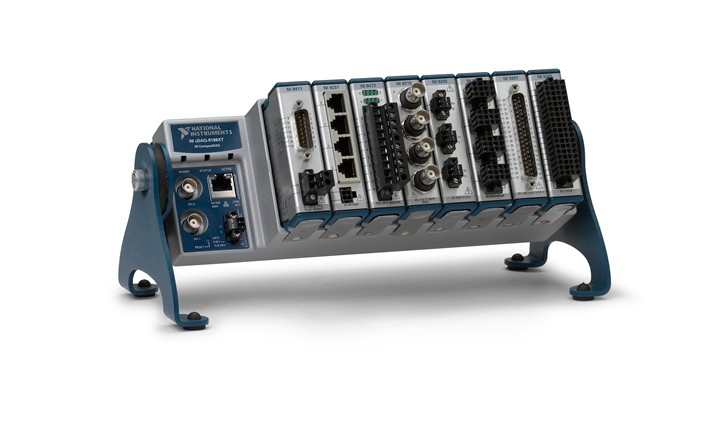Displacement and Position Sensors
Contents
- Types of Displacement and Position Sensors
- Designing the Right Measurement System for Displacement and Position Sensors
- NI Measurement Systems for Displacement and Position Sensors
Types of Displacement and Position Sensors
Proximity probes, linear variable differential transformers (LVDTs), and rotary variable differential transformers (RVDTs) are popular sensors for measuring position. However, there are many different ways to measure position, including encoders and string potentiometers.
Figure 1. Eddy current proximity probes are sensors that measure relative proximity.
Eddy current proximity probes are sensors that measure relative proximity. They use changes in voltage to measure shaft surfaces that rotate or reciprocate. Because they are noncontacting transducers, proximity probes are mounted on a reasonably stationary mechanical structure, such as a bearing housing. From the mounting point, they measure the static and dynamic displacement behavior of the moving machinery. Use the proximity probe measurement type when you want to measure a dynamic position, such as an air gap between parts of moving machinery.
Figure 2. LVDTs operate on the principle of a transformer and consist of a stationary coil assembly and a moveable core.
LVDTs operate on the principle of a transformer and consist of a stationary coil assembly and a moveable core. An LVDT measures displacement by associating a specific signal value for any given position of the core. LVDT signal conditioners generate a sine wave for the primary output signal and synchronously demodulate the secondary output signal. The demodulated output is passed through a lowpass filter to remove high-frequency ripple. The resulting output is a DC voltage proportional to core displacement. The sign of the DC voltage indicates whether the displacement is to the left or right. The main advantage of the LVDT transducer over other types of displacement transducer is the high degree of power.
RVDTs are the rotational version of LVDTs and generally operate over an angular range of ±30°–70°.
Designing the Right Measurement System for Displacement and Position Sensors
Excitation
LVDTs require an AC excitation source to the primary coil, typically between 50 Hz and 25 kHz. The frequency of the signal should be at least 10 times greater than the highest expected frequency of the core motion.
Proximity probes require excitation; however, the source is included with the sensor and will not be needed from the signal conditioning hardware.
Dynamic Range
Dynamic range is a measure of how small you can measure a signal relative to the maximum input signal the device can measure. Expressed in decibels, the dynamic range is 20 log (Vmax/Vmin). For example, a device with an input range of ±10 V and a dynamic range greater than 110 dB may have a voltage ratio of 106. Thus, with a maximum signal of 10 V, the smallest signal that you can see on the device is 10 µV. Thus, the required dynamic range is important in selecting the hardware for your system.
Voltage Range
Proximity probes output voltage levels at 15–30 V, which is much higher than many common sensors. It is important that the acquisition hardware that you select is appropriate for the voltage output range of your sensor.
Filtering
To be sure that you are sampling the correct range of frequencies, add a lowpass filter before the sampler and ADC. This ensures that you attenuate higher-frequency noise and that these aliasing components above the sampling rate do not distort the measurement.
NI Measurement Systems for Displacement and Position Sensors
National Instruments offers different signal conditioning platforms depending on sensor type, excitation, voltage range, and other needs of your application.
PXI
Figure 3. The high-performance PXI platform is recommended for measuring proximity with Eddy current probes.
The high-performance PXI platform is recommended for measuring proximity with Eddy current probes. PXI modules for proximity sensors have input voltages up to ±42 V with simultaneously sampled inputs at up to 204.8 kS/s. Modules include software and hardware needed to make precision measurements with transducers that have very large dynamic ranges, such as sound, vibration, and proximity sensors.
Shop PXI for proximity probe measurements
NI CompactDAQ
Figure 4. NI CompactDAQ is the best solution for portable and low-cost proximity measurements.
NI CompactDAQ is the best solution for portable and low-cost proximity measurements. The NI 9229 module for proximity measurements provides ±60 V input range, a dynamic range of 128 dB, antialias filtering, channel-to-channel isolation, 50 kS/s/ch simultaneously sampled. This module, designed to be high-speed and accurate, is also an effective general-purpose analog module because of its resolution, sample rate, and input range.



